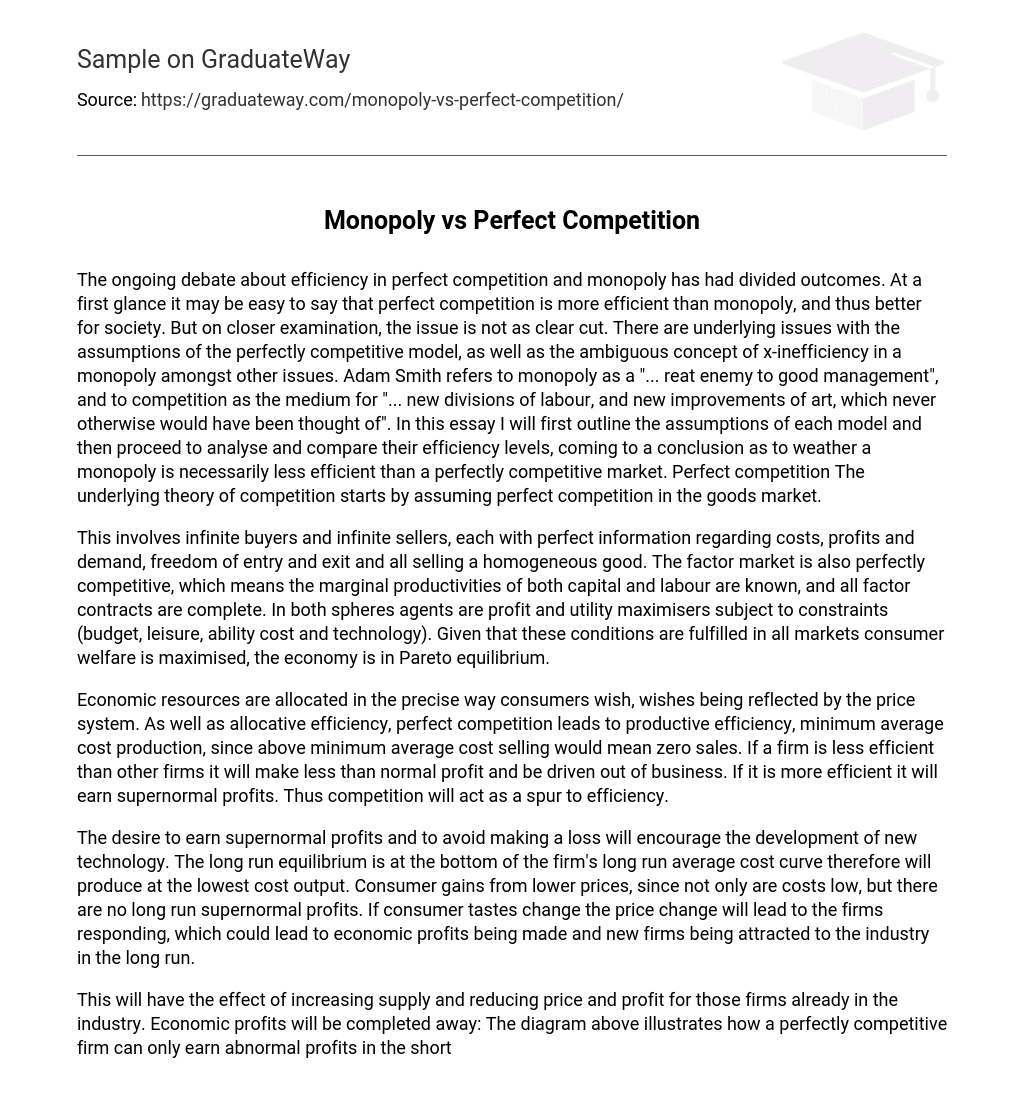The ongoing debate about efficiency in perfect competition and monopoly has had divided outcomes. At a first glance it may be easy to say that perfect competition is more efficient than monopoly, and thus better for society. But on closer examination, the issue is not as clear cut. There are underlying issues with the assumptions of the perfectly competitive model, as well as the ambiguous concept of x-inefficiency in a monopoly amongst other issues. Adam Smith refers to monopoly as a “… reat enemy to good management”, and to competition as the medium for “… new divisions of labour, and new improvements of art, which never otherwise would have been thought of”. In this essay I will first outline the assumptions of each model and then proceed to analyse and compare their efficiency levels, coming to a conclusion as to weather a monopoly is necessarily less efficient than a perfectly competitive market. Perfect competition The underlying theory of competition starts by assuming perfect competition in the goods market.
This involves infinite buyers and infinite sellers, each with perfect information regarding costs, profits and demand, freedom of entry and exit and all selling a homogeneous good. The factor market is also perfectly competitive, which means the marginal productivities of both capital and labour are known, and all factor contracts are complete. In both spheres agents are profit and utility maximisers subject to constraints (budget, leisure, ability cost and technology). Given that these conditions are fulfilled in all markets consumer welfare is maximised, the economy is in Pareto equilibrium.
Economic resources are allocated in the precise way consumers wish, wishes being reflected by the price system. As well as allocative efficiency, perfect competition leads to productive efficiency, minimum average cost production, since above minimum average cost selling would mean zero sales. If a firm is less efficient than other firms it will make less than normal profit and be driven out of business. If it is more efficient it will earn supernormal profits. Thus competition will act as a spur to efficiency.
The desire to earn supernormal profits and to avoid making a loss will encourage the development of new technology. The long run equilibrium is at the bottom of the firm’s long run average cost curve therefore will produce at the lowest cost output. Consumer gains from lower prices, since not only are costs low, but there are no long run supernormal profits. If consumer tastes change the price change will lead to the firms responding, which could lead to economic profits being made and new firms being attracted to the industry in the long run.
This will have the effect of increasing supply and reducing price and profit for those firms already in the industry. Economic profits will be completed away: The diagram above illustrates how a perfectly competitive firm can only earn abnormal profits in the short run. As there are no barriers to entry in a perfectly competitive industry, the perfect knowledge will allow other firms in other industries to see that abnormal profits can be made in this industry, and they will move into it.
This will cause the supply to increase, indicated by the shift in the supply curve from S1 to S2, this will drive the demand curve of the firm and eliminate the abnormal profits, and price is reduced to P2, at the efficient level. Paul Samuelson’s (1970) said : “Under perfectly perfect competition, where all prices end up equal to all marginal costs, where all factor-prices end up equal to values of marginal products and all total costs are minimized . . . then the resulting equilibrium has the efficiency property that ‘you cannot make any one man better off without hurting some other man’ ” (Schwartzman 1973).
Monopoly On the opposite end of the scale, we have the market structure of a monopoly, one producer. It is assumed that there are barriers to entry in thus industry deterring competition. Decreasing marginal and total costs act as a barrier to entry, so larger firms have lower unit costs, economies of scale due to technology. A firm can drive other firms out of the industry by cutting prices, and after the monopoly is established, new firms will find it hard to enter because of high costs.
This is the case in natural monopoly, which will be discussed later. Patents or copyrights can cause monopolies. Without patents, there would be little or no incentive for the monopoly to innovate, and this is the argument used to support patents. However, there exists the issue of x-inefficiency, which will be discussed later in the essay. A monopoly will choose to produce at the profit maximising point where marginal revenue equals marginal cost, MR=MC. MR is less than the market price, MR





